H&M Strategic Management Analysis
VerifiedAdded on 2023/05/29
|17
|3590
|303
AI Summary
This paper evaluates the business management strategies of H&M in comparison to its competitors. It includes competitor analysis, Ansoff Matrix, BCG Matrix, and critical evaluation of the company's strategy.
Contribute Materials
Your contribution can guide someone’s learning journey. Share your
documents today.
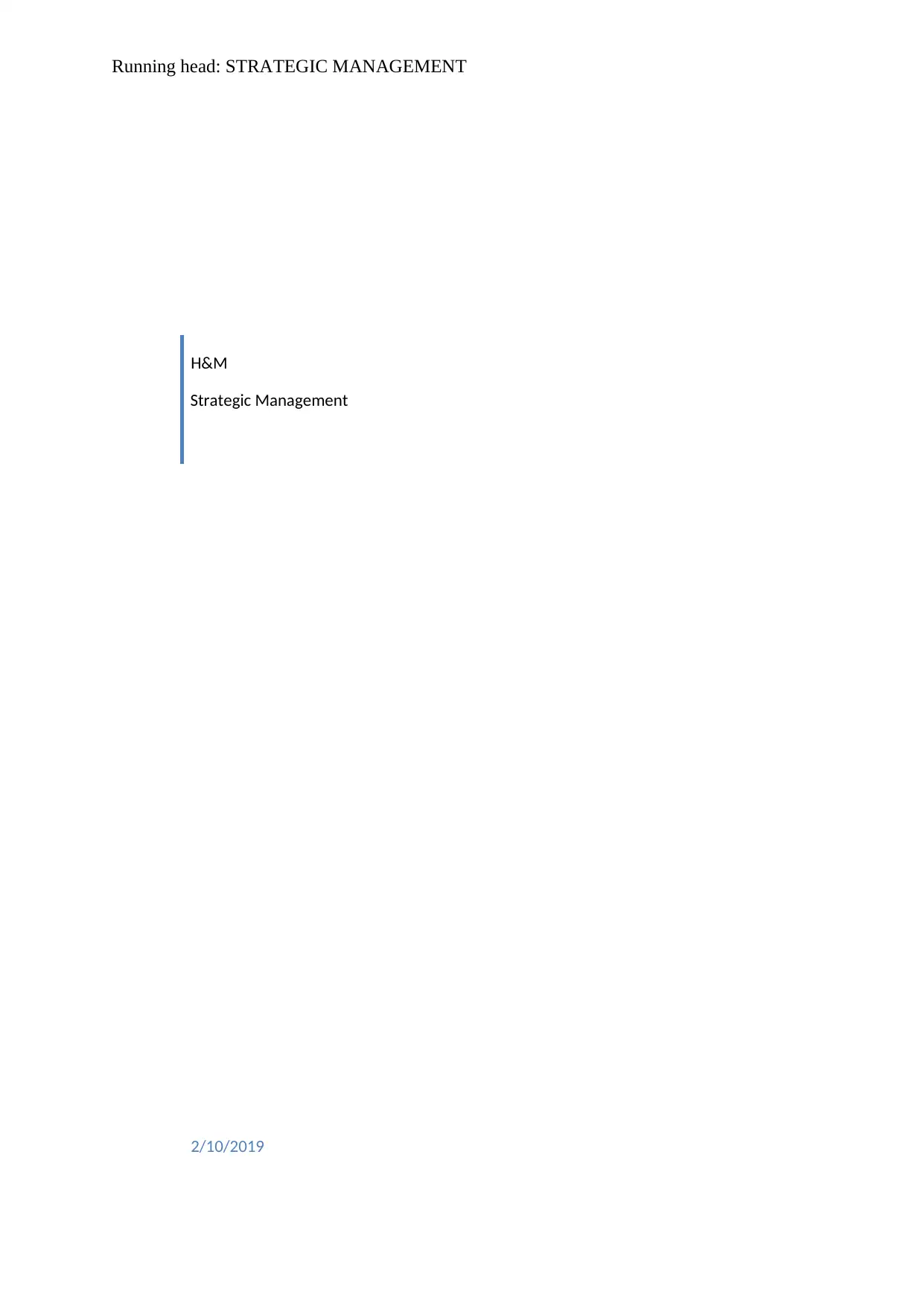
Running head: STRATEGIC MANAGEMENT
H&M
Strategic Management
2/10/2019
H&M
Strategic Management
2/10/2019
Secure Best Marks with AI Grader
Need help grading? Try our AI Grader for instant feedback on your assignments.
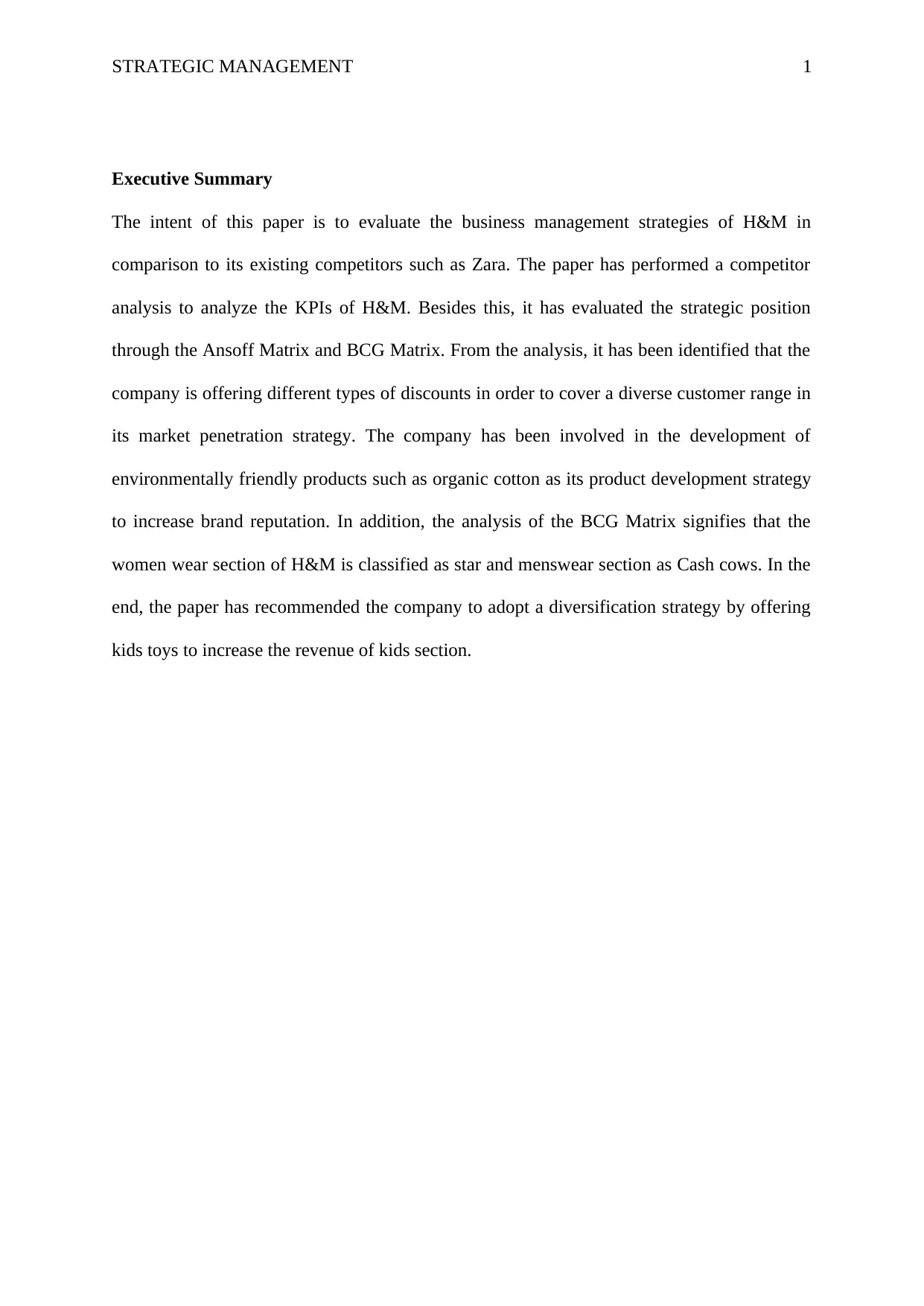
STRATEGIC MANAGEMENT 1
Executive Summary
The intent of this paper is to evaluate the business management strategies of H&M in
comparison to its existing competitors such as Zara. The paper has performed a competitor
analysis to analyze the KPIs of H&M. Besides this, it has evaluated the strategic position
through the Ansoff Matrix and BCG Matrix. From the analysis, it has been identified that the
company is offering different types of discounts in order to cover a diverse customer range in
its market penetration strategy. The company has been involved in the development of
environmentally friendly products such as organic cotton as its product development strategy
to increase brand reputation. In addition, the analysis of the BCG Matrix signifies that the
women wear section of H&M is classified as star and menswear section as Cash cows. In the
end, the paper has recommended the company to adopt a diversification strategy by offering
kids toys to increase the revenue of kids section.
Executive Summary
The intent of this paper is to evaluate the business management strategies of H&M in
comparison to its existing competitors such as Zara. The paper has performed a competitor
analysis to analyze the KPIs of H&M. Besides this, it has evaluated the strategic position
through the Ansoff Matrix and BCG Matrix. From the analysis, it has been identified that the
company is offering different types of discounts in order to cover a diverse customer range in
its market penetration strategy. The company has been involved in the development of
environmentally friendly products such as organic cotton as its product development strategy
to increase brand reputation. In addition, the analysis of the BCG Matrix signifies that the
women wear section of H&M is classified as star and menswear section as Cash cows. In the
end, the paper has recommended the company to adopt a diversification strategy by offering
kids toys to increase the revenue of kids section.
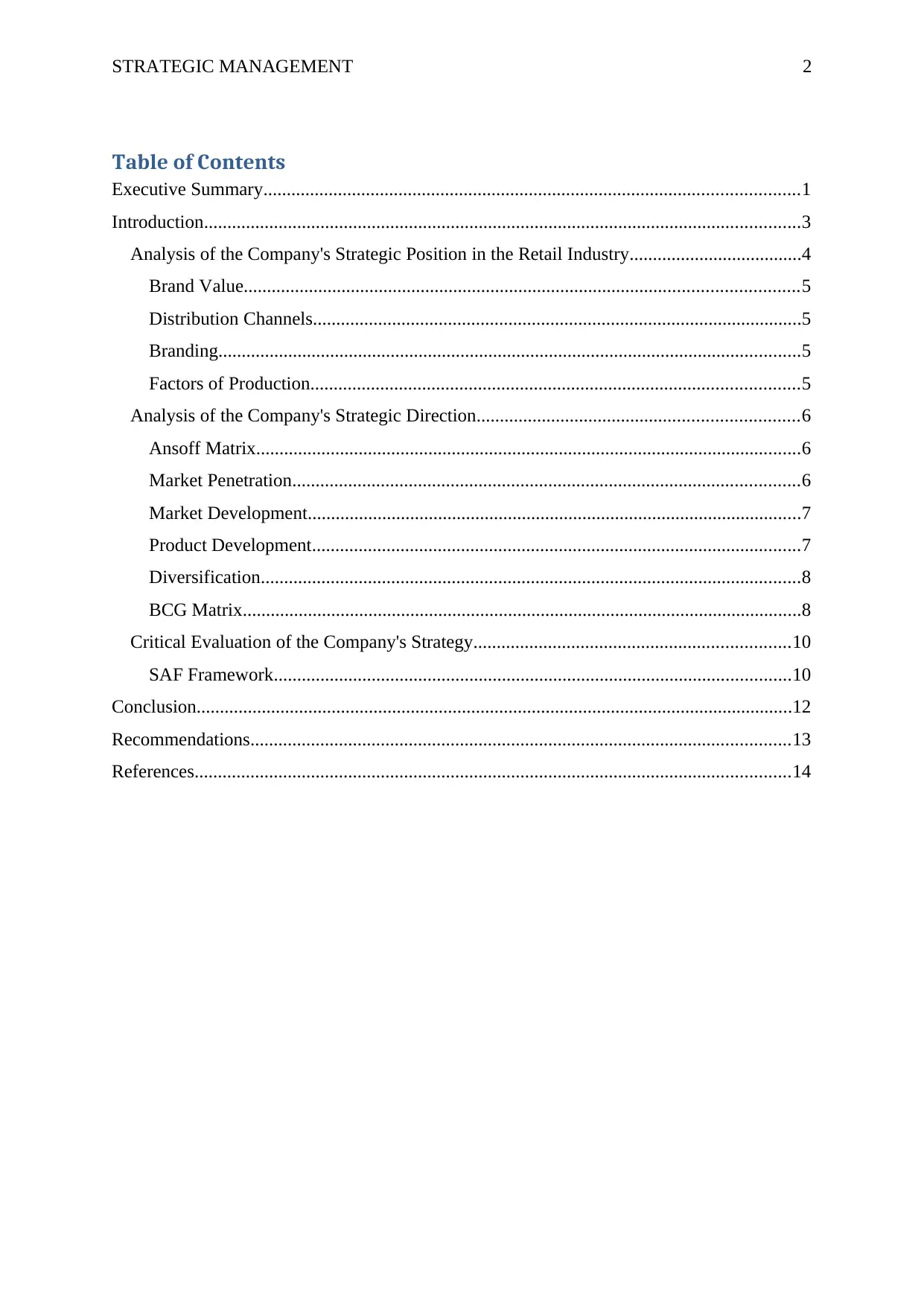
STRATEGIC MANAGEMENT 2
Table of Contents
Executive Summary...................................................................................................................1
Introduction................................................................................................................................3
Analysis of the Company's Strategic Position in the Retail Industry.....................................4
Brand Value.......................................................................................................................5
Distribution Channels.........................................................................................................5
Branding.............................................................................................................................5
Factors of Production.........................................................................................................5
Analysis of the Company's Strategic Direction.....................................................................6
Ansoff Matrix.....................................................................................................................6
Market Penetration.............................................................................................................6
Market Development..........................................................................................................7
Product Development.........................................................................................................7
Diversification....................................................................................................................8
BCG Matrix........................................................................................................................8
Critical Evaluation of the Company's Strategy....................................................................10
SAF Framework...............................................................................................................10
Conclusion................................................................................................................................12
Recommendations....................................................................................................................13
References................................................................................................................................14
Table of Contents
Executive Summary...................................................................................................................1
Introduction................................................................................................................................3
Analysis of the Company's Strategic Position in the Retail Industry.....................................4
Brand Value.......................................................................................................................5
Distribution Channels.........................................................................................................5
Branding.............................................................................................................................5
Factors of Production.........................................................................................................5
Analysis of the Company's Strategic Direction.....................................................................6
Ansoff Matrix.....................................................................................................................6
Market Penetration.............................................................................................................6
Market Development..........................................................................................................7
Product Development.........................................................................................................7
Diversification....................................................................................................................8
BCG Matrix........................................................................................................................8
Critical Evaluation of the Company's Strategy....................................................................10
SAF Framework...............................................................................................................10
Conclusion................................................................................................................................12
Recommendations....................................................................................................................13
References................................................................................................................................14

STRATEGIC MANAGEMENT 3
Introduction
Hennes & Mauritz AB is one of the well-known multinational companies of cloth
retailing established in Sweden. It is known in the market for offering fast-fashion for
children, teenagers, women, and men. H&M and its subsidiaries operate their
business in 62 nations with around 4,500 stores. As of 2015, the company hired over
132,000 people (H&M, 2019f). H&M is ranked second among the clothing retailers in
the world, which is just after Spain-based Inditex the parent company of Zara.
Besides Zara, the company has a number of competitors in the market like Uniqlo,
Gap, ASOS, Macy’s, American Eagle Outfitters, etc. It has a major online presence
in around 33 nations. In 2017, the total sales of the entire group were around 28
billion U.S. dollars, and from this, 1.2 billion U.S. dollars were earned in Sweden
(H&M, 2019g).
Strategies of Hennes & Mauritz
The H&M Group is focused on making the fashion enjoyable for today and future
generation. However, in order to make a sustainable fashion, they need to take their
work to next level. The vision of the company is to make use of its scale and size in
order to lead the change in the direction of the renewable and circular fashion
industry (H&M, 2019a). The vision and strategy of H&M are based on three
ambitions:
100% Circular and Renewable
Using only recycled and sustainably manufactured products
A circular approach the way products are manufactured and used
A climate positive value chain
Introduction
Hennes & Mauritz AB is one of the well-known multinational companies of cloth
retailing established in Sweden. It is known in the market for offering fast-fashion for
children, teenagers, women, and men. H&M and its subsidiaries operate their
business in 62 nations with around 4,500 stores. As of 2015, the company hired over
132,000 people (H&M, 2019f). H&M is ranked second among the clothing retailers in
the world, which is just after Spain-based Inditex the parent company of Zara.
Besides Zara, the company has a number of competitors in the market like Uniqlo,
Gap, ASOS, Macy’s, American Eagle Outfitters, etc. It has a major online presence
in around 33 nations. In 2017, the total sales of the entire group were around 28
billion U.S. dollars, and from this, 1.2 billion U.S. dollars were earned in Sweden
(H&M, 2019g).
Strategies of Hennes & Mauritz
The H&M Group is focused on making the fashion enjoyable for today and future
generation. However, in order to make a sustainable fashion, they need to take their
work to next level. The vision of the company is to make use of its scale and size in
order to lead the change in the direction of the renewable and circular fashion
industry (H&M, 2019a). The vision and strategy of H&M are based on three
ambitions:
100% Circular and Renewable
Using only recycled and sustainably manufactured products
A circular approach the way products are manufactured and used
A climate positive value chain
Secure Best Marks with AI Grader
Need help grading? Try our AI Grader for instant feedback on your assignments.

STRATEGIC MANAGEMENT 4
100% Fair and Equal
Stewards for diversity and extensiveness
Fair Jobs to all (H&M, 2019b)
100% Leading the Change
Reward viable actions
Drive transparency
Promote innovation
Retail Industry Analysis
The economy of Sweden has started recovering in 2018, with the increasing GDP of
2.42% in comparison to the 2017 that is 2.11%. Besides this, the unemployment rate
of the country is decreasing, whereas the disposable income and wages of people
are increasing. In spite of these positives, Sweden retailing has sustained to record
only reasonable value growth in 2018 (Euromonitor International, 2019).
Analysis of the Company's Strategic Position in the Retail Industry
H&M, Zara, and Uniqlo are said to be the three key international retailers of cloths
with around 1000 stores each globally. All the three businesses have a similar type
of target market however adopt different strategies in their operations in order to
handle the product distribution. From the analysis, it has been analyzed, then Zara
and H&M are giving high competition to each other in order to be the superior
fashion brand across the globe.
Brand Value
The brand value of H&M is 13 billion euros, which makes it the fashion brand with
the highest value in the Europe market. On the other side, the equally ambitious
100% Fair and Equal
Stewards for diversity and extensiveness
Fair Jobs to all (H&M, 2019b)
100% Leading the Change
Reward viable actions
Drive transparency
Promote innovation
Retail Industry Analysis
The economy of Sweden has started recovering in 2018, with the increasing GDP of
2.42% in comparison to the 2017 that is 2.11%. Besides this, the unemployment rate
of the country is decreasing, whereas the disposable income and wages of people
are increasing. In spite of these positives, Sweden retailing has sustained to record
only reasonable value growth in 2018 (Euromonitor International, 2019).
Analysis of the Company's Strategic Position in the Retail Industry
H&M, Zara, and Uniqlo are said to be the three key international retailers of cloths
with around 1000 stores each globally. All the three businesses have a similar type
of target market however adopt different strategies in their operations in order to
handle the product distribution. From the analysis, it has been analyzed, then Zara
and H&M are giving high competition to each other in order to be the superior
fashion brand across the globe.
Brand Value
The brand value of H&M is 13 billion euros, which makes it the fashion brand with
the highest value in the Europe market. On the other side, the equally ambitious
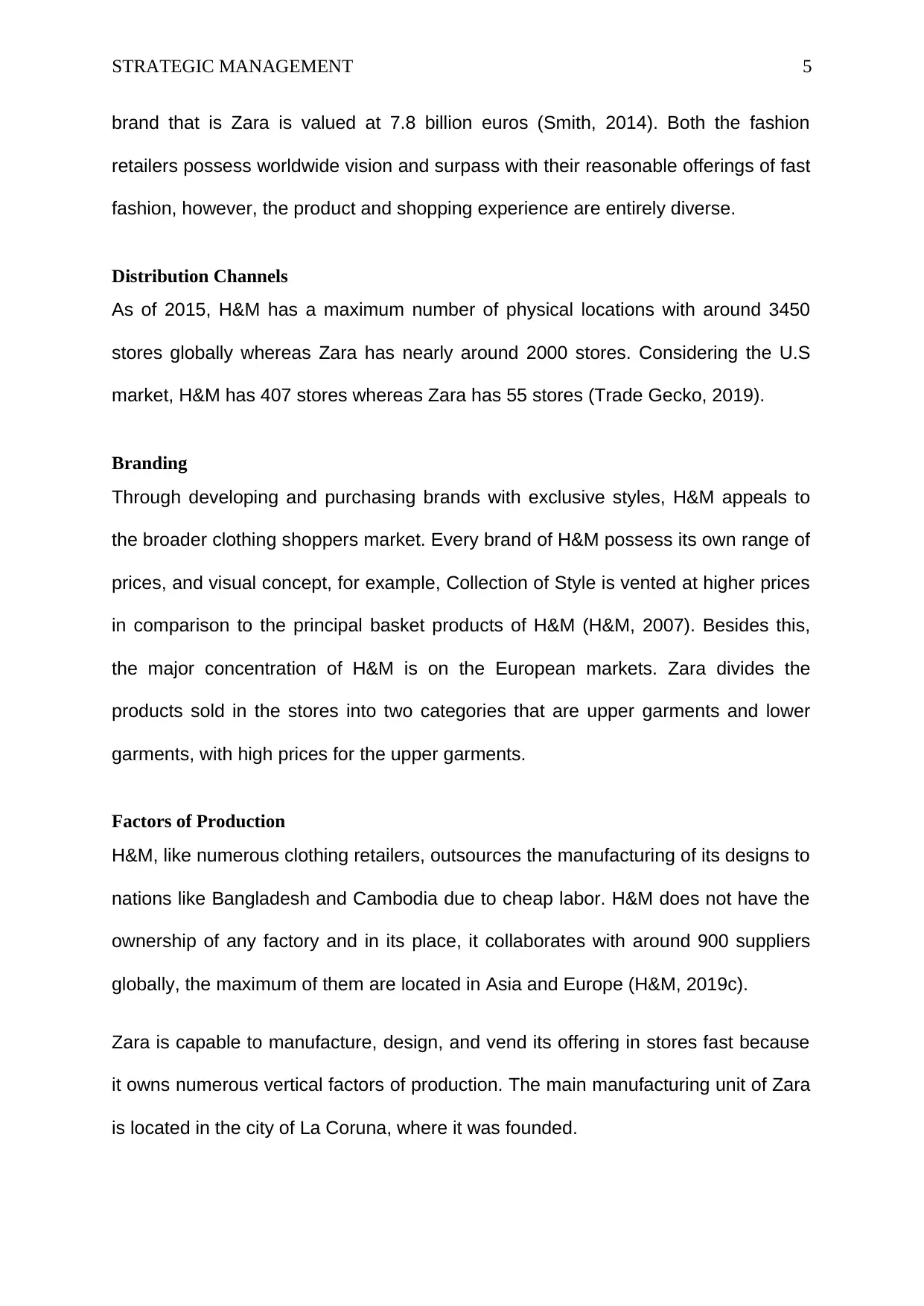
STRATEGIC MANAGEMENT 5
brand that is Zara is valued at 7.8 billion euros (Smith, 2014). Both the fashion
retailers possess worldwide vision and surpass with their reasonable offerings of fast
fashion, however, the product and shopping experience are entirely diverse.
Distribution Channels
As of 2015, H&M has a maximum number of physical locations with around 3450
stores globally whereas Zara has nearly around 2000 stores. Considering the U.S
market, H&M has 407 stores whereas Zara has 55 stores (Trade Gecko, 2019).
Branding
Through developing and purchasing brands with exclusive styles, H&M appeals to
the broader clothing shoppers market. Every brand of H&M possess its own range of
prices, and visual concept, for example, Collection of Style is vented at higher prices
in comparison to the principal basket products of H&M (H&M, 2007). Besides this,
the major concentration of H&M is on the European markets. Zara divides the
products sold in the stores into two categories that are upper garments and lower
garments, with high prices for the upper garments.
Factors of Production
H&M, like numerous clothing retailers, outsources the manufacturing of its designs to
nations like Bangladesh and Cambodia due to cheap labor. H&M does not have the
ownership of any factory and in its place, it collaborates with around 900 suppliers
globally, the maximum of them are located in Asia and Europe (H&M, 2019c).
Zara is capable to manufacture, design, and vend its offering in stores fast because
it owns numerous vertical factors of production. The main manufacturing unit of Zara
is located in the city of La Coruna, where it was founded.
brand that is Zara is valued at 7.8 billion euros (Smith, 2014). Both the fashion
retailers possess worldwide vision and surpass with their reasonable offerings of fast
fashion, however, the product and shopping experience are entirely diverse.
Distribution Channels
As of 2015, H&M has a maximum number of physical locations with around 3450
stores globally whereas Zara has nearly around 2000 stores. Considering the U.S
market, H&M has 407 stores whereas Zara has 55 stores (Trade Gecko, 2019).
Branding
Through developing and purchasing brands with exclusive styles, H&M appeals to
the broader clothing shoppers market. Every brand of H&M possess its own range of
prices, and visual concept, for example, Collection of Style is vented at higher prices
in comparison to the principal basket products of H&M (H&M, 2007). Besides this,
the major concentration of H&M is on the European markets. Zara divides the
products sold in the stores into two categories that are upper garments and lower
garments, with high prices for the upper garments.
Factors of Production
H&M, like numerous clothing retailers, outsources the manufacturing of its designs to
nations like Bangladesh and Cambodia due to cheap labor. H&M does not have the
ownership of any factory and in its place, it collaborates with around 900 suppliers
globally, the maximum of them are located in Asia and Europe (H&M, 2019c).
Zara is capable to manufacture, design, and vend its offering in stores fast because
it owns numerous vertical factors of production. The main manufacturing unit of Zara
is located in the city of La Coruna, where it was founded.

STRATEGIC MANAGEMENT 6
Analysis of the Company's Strategic Direction
Ansoff Matrix
The Ansoff Matrix is said to be a tool of strategic planning that offers an outline to
assist senior managers, and markers plan strategies for future business growth. The
name of the matrix is based on its Russian founder that is Igor Ansoff (Bachmeier,
2013). The matrix is based on four different strategies adopted by the business to its
growth that are:
Source [(Corporate Finance Institute, 2019)]
Market Penetration
The strategy of market penetration is used by the businesses to grow in the market
with the help of its existing products and services in the existing markets. Through
this, the business put its efforts to increase its share in the existing market area. This
could be attained by vending more services to the established consumers or by
identifying new consumers in the existing market (Fortin, 2017).
Under Market Penetration, H&M is providing fashionable clothing products to
customers at reasonable prices than other rivals like Zara. The company has
Analysis of the Company's Strategic Direction
Ansoff Matrix
The Ansoff Matrix is said to be a tool of strategic planning that offers an outline to
assist senior managers, and markers plan strategies for future business growth. The
name of the matrix is based on its Russian founder that is Igor Ansoff (Bachmeier,
2013). The matrix is based on four different strategies adopted by the business to its
growth that are:
Source [(Corporate Finance Institute, 2019)]
Market Penetration
The strategy of market penetration is used by the businesses to grow in the market
with the help of its existing products and services in the existing markets. Through
this, the business put its efforts to increase its share in the existing market area. This
could be attained by vending more services to the established consumers or by
identifying new consumers in the existing market (Fortin, 2017).
Under Market Penetration, H&M is providing fashionable clothing products to
customers at reasonable prices than other rivals like Zara. The company has
Paraphrase This Document
Need a fresh take? Get an instant paraphrase of this document with our AI Paraphraser

STRATEGIC MANAGEMENT 7
adopted a wider pricing range in order to suit all the sphere of buyer and
merchandiser. H&M attract new customers by keeping a lot of its stock in the
discounted section as a median pricing strategy (Bhasin, 2017). It is known that the
foundation of a successful brand is its quality. H&M is very particular about its
product and quality; therefore, it has adopted inclusive methods of quality control,
which guarantee customer satisfaction. Besides this, with the support of effective
advertising campaigns business is able to increase its worldwide popularity
supported by the globalization of developing trends and lifestyle.
Market Development
In the strategy of market development, a company put its efforts to expand into new
and developed markets with the help of its existing offerings.
The internationalization strategy of H&M is grounded on entering one new market at
a time. The products of the H&M are standardized, though it adopts little changes in
its offerings according to the new market culture. As per the new segment, the
business has introduced COS (Collection of Style) with more smarter and expensive
clothes in comparison to the common products of the company (H&M, 2007).
Product Development
In the strategy of product development, a business put its efforts to make new
services and products targeted at the existing market for business growth. This
strategy is comprised of extending the range of product accessible in the existing
market of the company (Archer, 2017).
H&M follow this strategy through a strategic alliance with well-known fashion icons
and designers such as Roberto Cavalli, Karl Lagerfeld, or Madonna, which enhance
the reputation of H&M globally. Besides this, the company is majorly involved in the
adopted a wider pricing range in order to suit all the sphere of buyer and
merchandiser. H&M attract new customers by keeping a lot of its stock in the
discounted section as a median pricing strategy (Bhasin, 2017). It is known that the
foundation of a successful brand is its quality. H&M is very particular about its
product and quality; therefore, it has adopted inclusive methods of quality control,
which guarantee customer satisfaction. Besides this, with the support of effective
advertising campaigns business is able to increase its worldwide popularity
supported by the globalization of developing trends and lifestyle.
Market Development
In the strategy of market development, a company put its efforts to expand into new
and developed markets with the help of its existing offerings.
The internationalization strategy of H&M is grounded on entering one new market at
a time. The products of the H&M are standardized, though it adopts little changes in
its offerings according to the new market culture. As per the new segment, the
business has introduced COS (Collection of Style) with more smarter and expensive
clothes in comparison to the common products of the company (H&M, 2007).
Product Development
In the strategy of product development, a business put its efforts to make new
services and products targeted at the existing market for business growth. This
strategy is comprised of extending the range of product accessible in the existing
market of the company (Archer, 2017).
H&M follow this strategy through a strategic alliance with well-known fashion icons
and designers such as Roberto Cavalli, Karl Lagerfeld, or Madonna, which enhance
the reputation of H&M globally. Besides this, the company is majorly involved in the
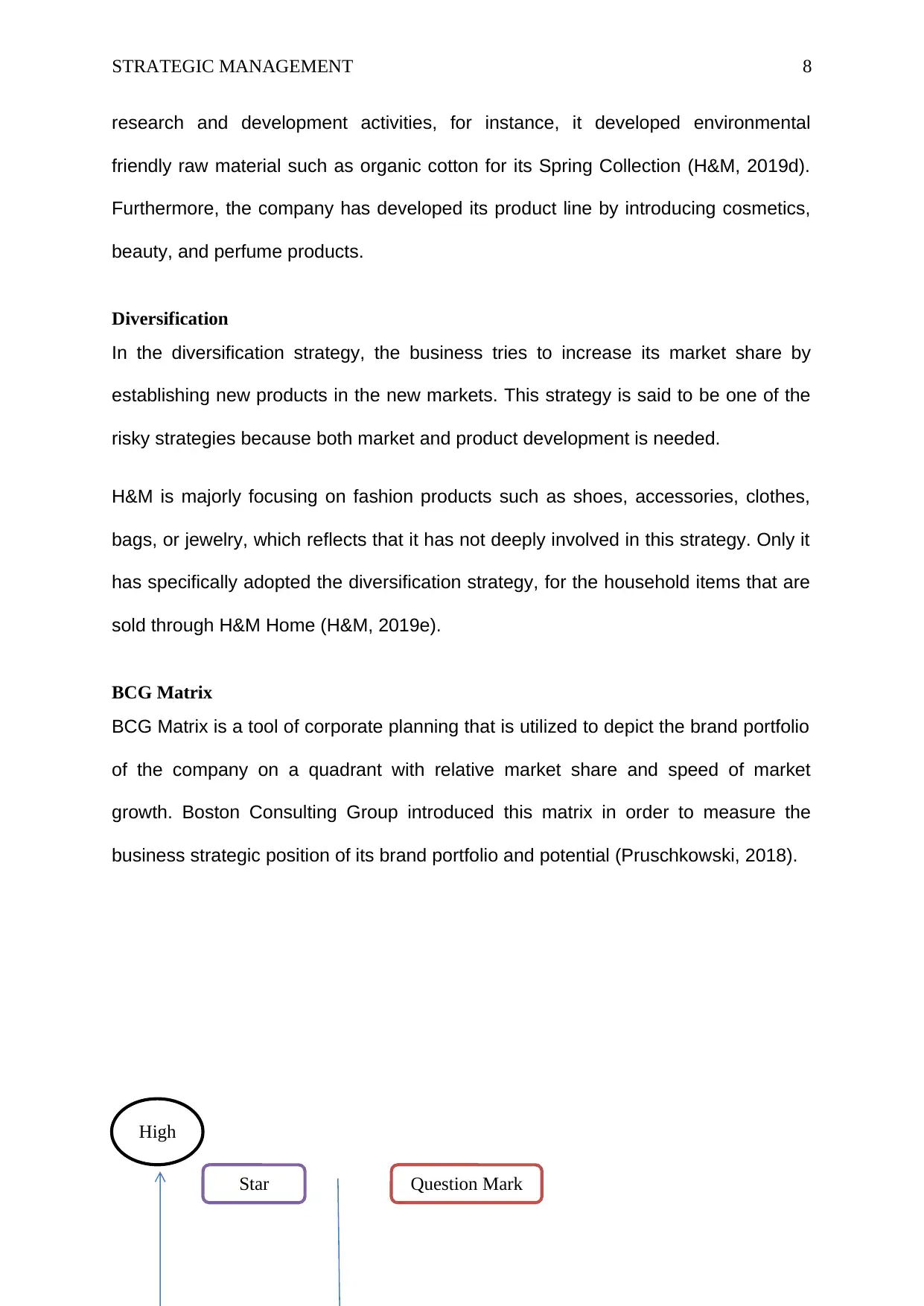
STRATEGIC MANAGEMENT 8
research and development activities, for instance, it developed environmental
friendly raw material such as organic cotton for its Spring Collection (H&M, 2019d).
Furthermore, the company has developed its product line by introducing cosmetics,
beauty, and perfume products.
Diversification
In the diversification strategy, the business tries to increase its market share by
establishing new products in the new markets. This strategy is said to be one of the
risky strategies because both market and product development is needed.
H&M is majorly focusing on fashion products such as shoes, accessories, clothes,
bags, or jewelry, which reflects that it has not deeply involved in this strategy. Only it
has specifically adopted the diversification strategy, for the household items that are
sold through H&M Home (H&M, 2019e).
BCG Matrix
BCG Matrix is a tool of corporate planning that is utilized to depict the brand portfolio
of the company on a quadrant with relative market share and speed of market
growth. Boston Consulting Group introduced this matrix in order to measure the
business strategic position of its brand portfolio and potential (Pruschkowski, 2018).
High
Star Question Mark
research and development activities, for instance, it developed environmental
friendly raw material such as organic cotton for its Spring Collection (H&M, 2019d).
Furthermore, the company has developed its product line by introducing cosmetics,
beauty, and perfume products.
Diversification
In the diversification strategy, the business tries to increase its market share by
establishing new products in the new markets. This strategy is said to be one of the
risky strategies because both market and product development is needed.
H&M is majorly focusing on fashion products such as shoes, accessories, clothes,
bags, or jewelry, which reflects that it has not deeply involved in this strategy. Only it
has specifically adopted the diversification strategy, for the household items that are
sold through H&M Home (H&M, 2019e).
BCG Matrix
BCG Matrix is a tool of corporate planning that is utilized to depict the brand portfolio
of the company on a quadrant with relative market share and speed of market
growth. Boston Consulting Group introduced this matrix in order to measure the
business strategic position of its brand portfolio and potential (Pruschkowski, 2018).
High
Star Question Mark
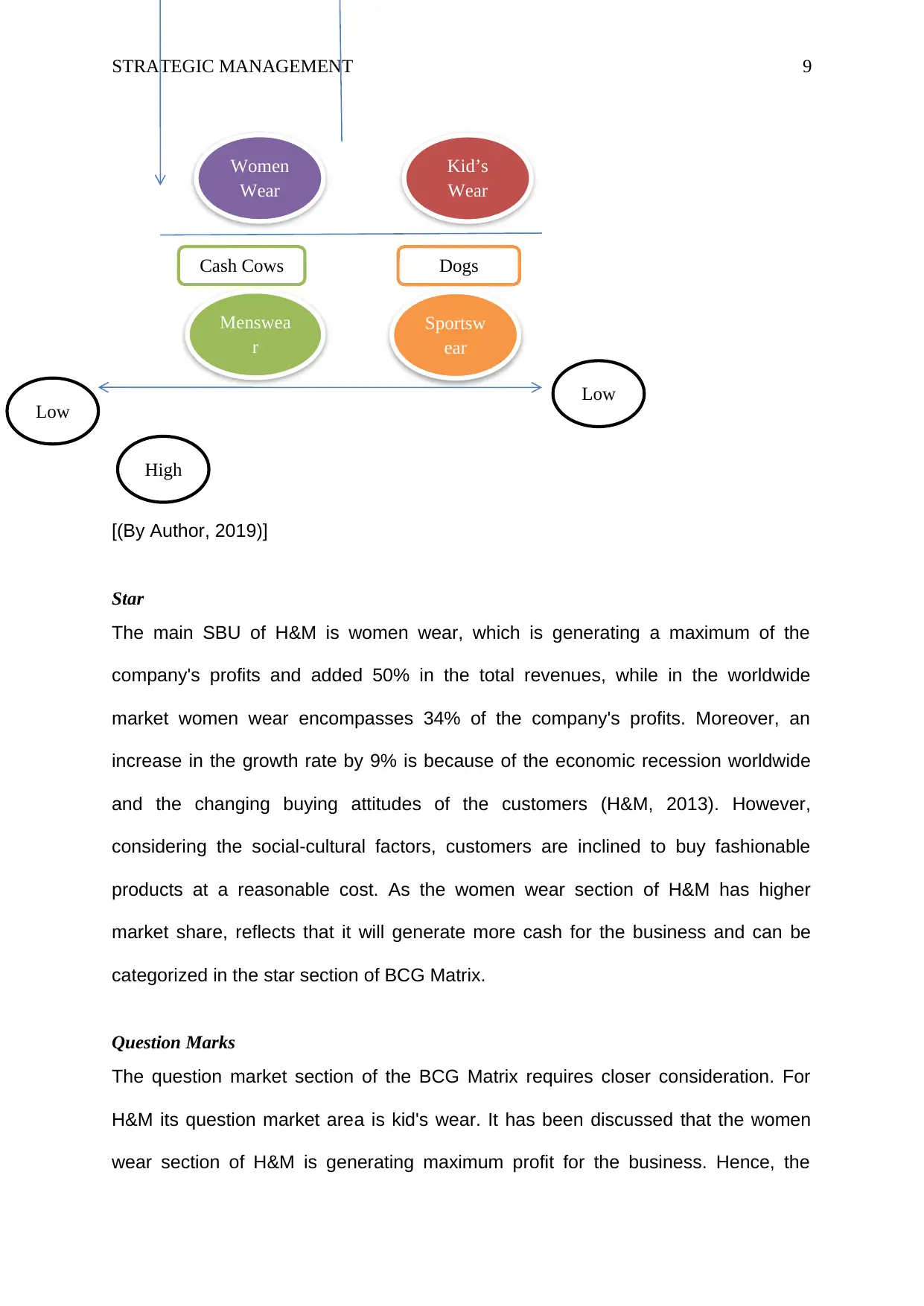
STRATEGIC MANAGEMENT 9
[(By Author, 2019)]
Star
The main SBU of H&M is women wear, which is generating a maximum of the
company's profits and added 50% in the total revenues, while in the worldwide
market women wear encompasses 34% of the company's profits. Moreover, an
increase in the growth rate by 9% is because of the economic recession worldwide
and the changing buying attitudes of the customers (H&M, 2013). However,
considering the social-cultural factors, customers are inclined to buy fashionable
products at a reasonable cost. As the women wear section of H&M has higher
market share, reflects that it will generate more cash for the business and can be
categorized in the star section of BCG Matrix.
Question Marks
The question market section of the BCG Matrix requires closer consideration. For
H&M its question market area is kid's wear. It has been discussed that the women
wear section of H&M is generating maximum profit for the business. Hence, the
High
Low Low
Cash Cows Dogs
Women
Wear
Kid’s
Wear
Menswea
r
Sportsw
ear
[(By Author, 2019)]
Star
The main SBU of H&M is women wear, which is generating a maximum of the
company's profits and added 50% in the total revenues, while in the worldwide
market women wear encompasses 34% of the company's profits. Moreover, an
increase in the growth rate by 9% is because of the economic recession worldwide
and the changing buying attitudes of the customers (H&M, 2013). However,
considering the social-cultural factors, customers are inclined to buy fashionable
products at a reasonable cost. As the women wear section of H&M has higher
market share, reflects that it will generate more cash for the business and can be
categorized in the star section of BCG Matrix.
Question Marks
The question market section of the BCG Matrix requires closer consideration. For
H&M its question market area is kid's wear. It has been discussed that the women
wear section of H&M is generating maximum profit for the business. Hence, the
High
Low Low
Cash Cows Dogs
Women
Wear
Kid’s
Wear
Menswea
r
Sportsw
ear
Secure Best Marks with AI Grader
Need help grading? Try our AI Grader for instant feedback on your assignments.
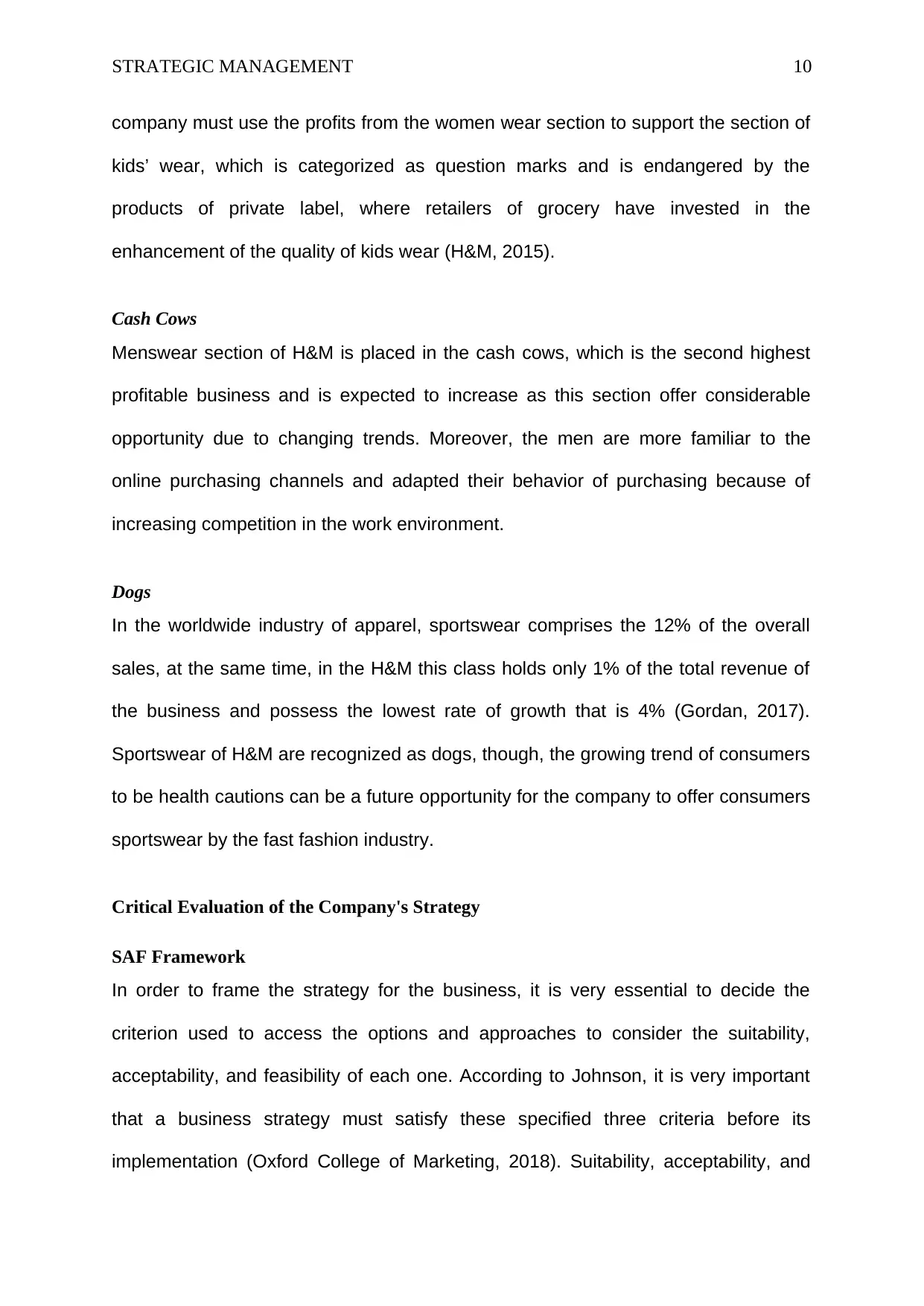
STRATEGIC MANAGEMENT 10
company must use the profits from the women wear section to support the section of
kids’ wear, which is categorized as question marks and is endangered by the
products of private label, where retailers of grocery have invested in the
enhancement of the quality of kids wear (H&M, 2015).
Cash Cows
Menswear section of H&M is placed in the cash cows, which is the second highest
profitable business and is expected to increase as this section offer considerable
opportunity due to changing trends. Moreover, the men are more familiar to the
online purchasing channels and adapted their behavior of purchasing because of
increasing competition in the work environment.
Dogs
In the worldwide industry of apparel, sportswear comprises the 12% of the overall
sales, at the same time, in the H&M this class holds only 1% of the total revenue of
the business and possess the lowest rate of growth that is 4% (Gordan, 2017).
Sportswear of H&M are recognized as dogs, though, the growing trend of consumers
to be health cautions can be a future opportunity for the company to offer consumers
sportswear by the fast fashion industry.
Critical Evaluation of the Company's Strategy
SAF Framework
In order to frame the strategy for the business, it is very essential to decide the
criterion used to access the options and approaches to consider the suitability,
acceptability, and feasibility of each one. According to Johnson, it is very important
that a business strategy must satisfy these specified three criteria before its
implementation (Oxford College of Marketing, 2018). Suitability, acceptability, and
company must use the profits from the women wear section to support the section of
kids’ wear, which is categorized as question marks and is endangered by the
products of private label, where retailers of grocery have invested in the
enhancement of the quality of kids wear (H&M, 2015).
Cash Cows
Menswear section of H&M is placed in the cash cows, which is the second highest
profitable business and is expected to increase as this section offer considerable
opportunity due to changing trends. Moreover, the men are more familiar to the
online purchasing channels and adapted their behavior of purchasing because of
increasing competition in the work environment.
Dogs
In the worldwide industry of apparel, sportswear comprises the 12% of the overall
sales, at the same time, in the H&M this class holds only 1% of the total revenue of
the business and possess the lowest rate of growth that is 4% (Gordan, 2017).
Sportswear of H&M are recognized as dogs, though, the growing trend of consumers
to be health cautions can be a future opportunity for the company to offer consumers
sportswear by the fast fashion industry.
Critical Evaluation of the Company's Strategy
SAF Framework
In order to frame the strategy for the business, it is very essential to decide the
criterion used to access the options and approaches to consider the suitability,
acceptability, and feasibility of each one. According to Johnson, it is very important
that a business strategy must satisfy these specified three criteria before its
implementation (Oxford College of Marketing, 2018). Suitability, acceptability, and
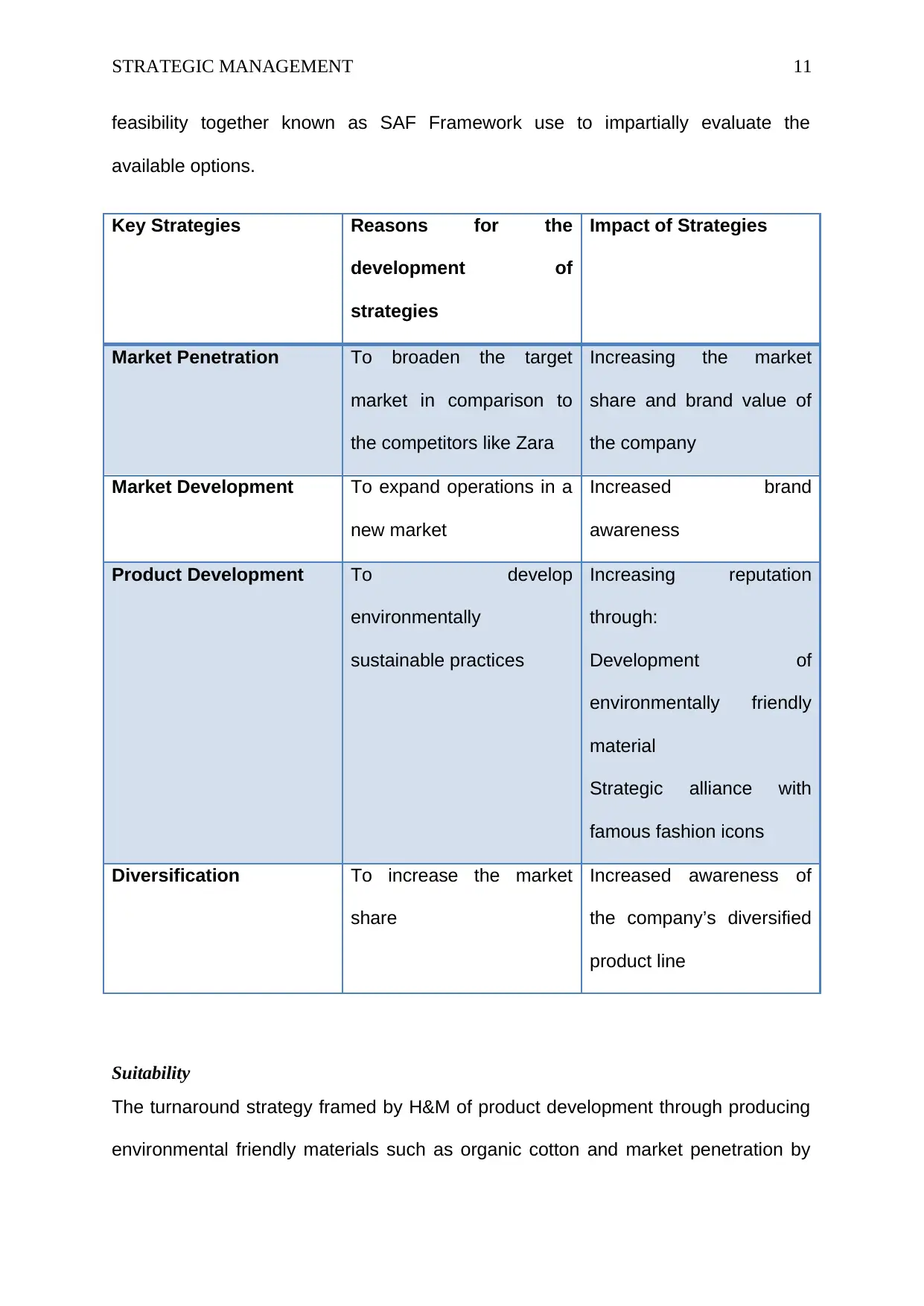
STRATEGIC MANAGEMENT 11
feasibility together known as SAF Framework use to impartially evaluate the
available options.
Key Strategies Reasons for the
development of
strategies
Impact of Strategies
Market Penetration To broaden the target
market in comparison to
the competitors like Zara
Increasing the market
share and brand value of
the company
Market Development To expand operations in a
new market
Increased brand
awareness
Product Development To develop
environmentally
sustainable practices
Increasing reputation
through:
Development of
environmentally friendly
material
Strategic alliance with
famous fashion icons
Diversification To increase the market
share
Increased awareness of
the company’s diversified
product line
Suitability
The turnaround strategy framed by H&M of product development through producing
environmental friendly materials such as organic cotton and market penetration by
feasibility together known as SAF Framework use to impartially evaluate the
available options.
Key Strategies Reasons for the
development of
strategies
Impact of Strategies
Market Penetration To broaden the target
market in comparison to
the competitors like Zara
Increasing the market
share and brand value of
the company
Market Development To expand operations in a
new market
Increased brand
awareness
Product Development To develop
environmentally
sustainable practices
Increasing reputation
through:
Development of
environmentally friendly
material
Strategic alliance with
famous fashion icons
Diversification To increase the market
share
Increased awareness of
the company’s diversified
product line
Suitability
The turnaround strategy framed by H&M of product development through producing
environmental friendly materials such as organic cotton and market penetration by
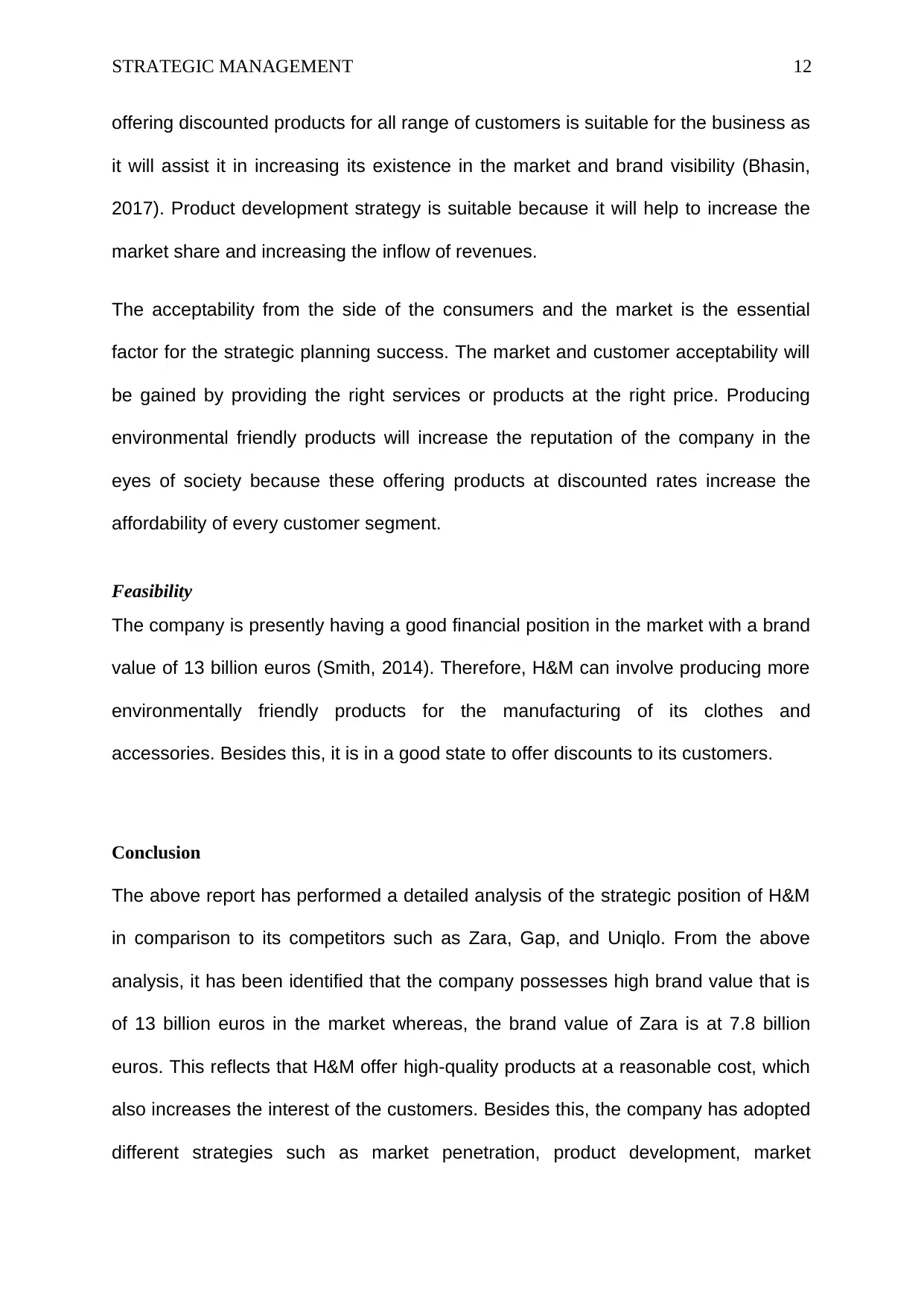
STRATEGIC MANAGEMENT 12
offering discounted products for all range of customers is suitable for the business as
it will assist it in increasing its existence in the market and brand visibility (Bhasin,
2017). Product development strategy is suitable because it will help to increase the
market share and increasing the inflow of revenues.
The acceptability from the side of the consumers and the market is the essential
factor for the strategic planning success. The market and customer acceptability will
be gained by providing the right services or products at the right price. Producing
environmental friendly products will increase the reputation of the company in the
eyes of society because these offering products at discounted rates increase the
affordability of every customer segment.
Feasibility
The company is presently having a good financial position in the market with a brand
value of 13 billion euros (Smith, 2014). Therefore, H&M can involve producing more
environmentally friendly products for the manufacturing of its clothes and
accessories. Besides this, it is in a good state to offer discounts to its customers.
Conclusion
The above report has performed a detailed analysis of the strategic position of H&M
in comparison to its competitors such as Zara, Gap, and Uniqlo. From the above
analysis, it has been identified that the company possesses high brand value that is
of 13 billion euros in the market whereas, the brand value of Zara is at 7.8 billion
euros. This reflects that H&M offer high-quality products at a reasonable cost, which
also increases the interest of the customers. Besides this, the company has adopted
different strategies such as market penetration, product development, market
offering discounted products for all range of customers is suitable for the business as
it will assist it in increasing its existence in the market and brand visibility (Bhasin,
2017). Product development strategy is suitable because it will help to increase the
market share and increasing the inflow of revenues.
The acceptability from the side of the consumers and the market is the essential
factor for the strategic planning success. The market and customer acceptability will
be gained by providing the right services or products at the right price. Producing
environmental friendly products will increase the reputation of the company in the
eyes of society because these offering products at discounted rates increase the
affordability of every customer segment.
Feasibility
The company is presently having a good financial position in the market with a brand
value of 13 billion euros (Smith, 2014). Therefore, H&M can involve producing more
environmentally friendly products for the manufacturing of its clothes and
accessories. Besides this, it is in a good state to offer discounts to its customers.
Conclusion
The above report has performed a detailed analysis of the strategic position of H&M
in comparison to its competitors such as Zara, Gap, and Uniqlo. From the above
analysis, it has been identified that the company possesses high brand value that is
of 13 billion euros in the market whereas, the brand value of Zara is at 7.8 billion
euros. This reflects that H&M offer high-quality products at a reasonable cost, which
also increases the interest of the customers. Besides this, the company has adopted
different strategies such as market penetration, product development, market
Paraphrase This Document
Need a fresh take? Get an instant paraphrase of this document with our AI Paraphraser
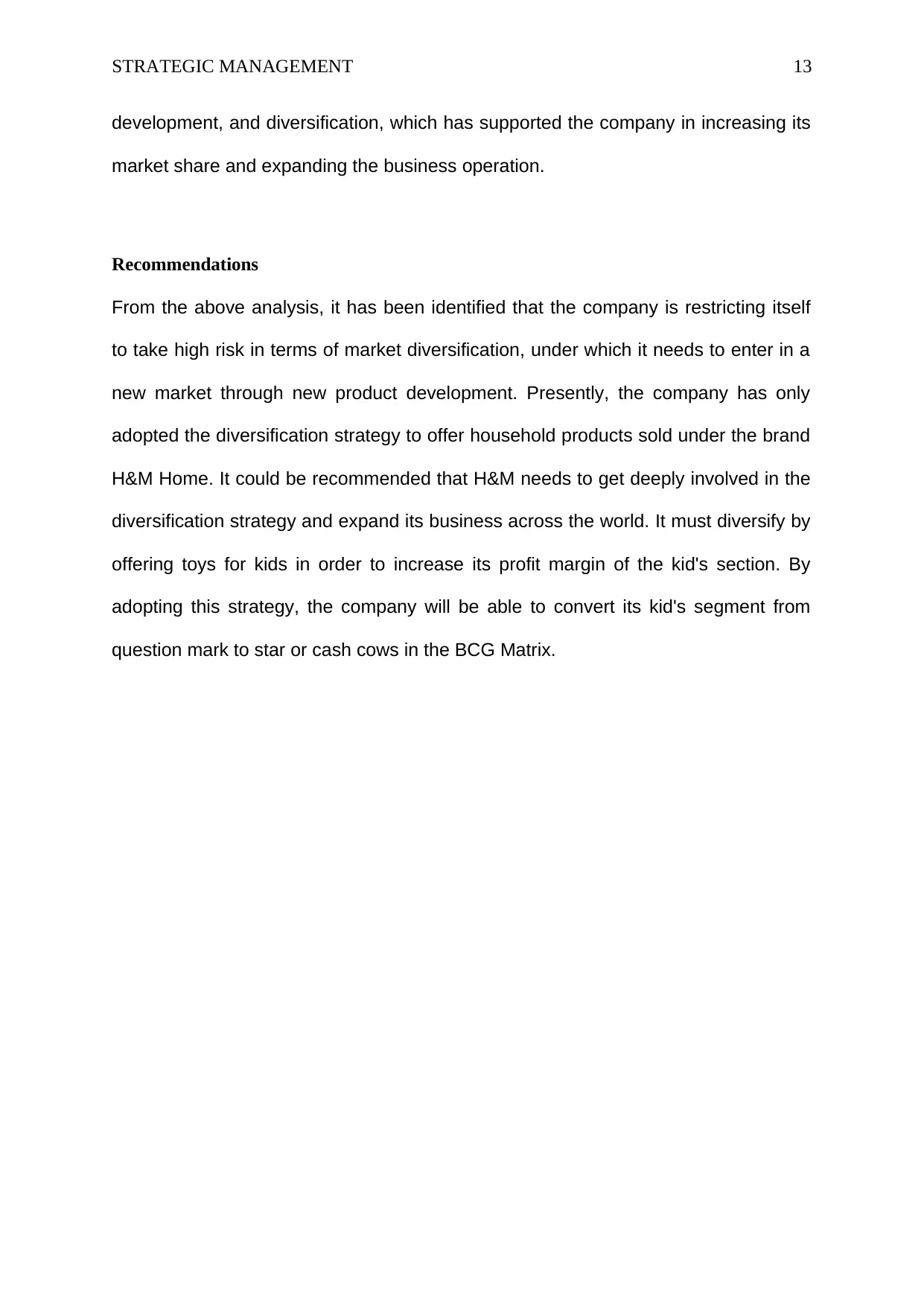
STRATEGIC MANAGEMENT 13
development, and diversification, which has supported the company in increasing its
market share and expanding the business operation.
Recommendations
From the above analysis, it has been identified that the company is restricting itself
to take high risk in terms of market diversification, under which it needs to enter in a
new market through new product development. Presently, the company has only
adopted the diversification strategy to offer household products sold under the brand
H&M Home. It could be recommended that H&M needs to get deeply involved in the
diversification strategy and expand its business across the world. It must diversify by
offering toys for kids in order to increase its profit margin of the kid's section. By
adopting this strategy, the company will be able to convert its kid's segment from
question mark to star or cash cows in the BCG Matrix.
development, and diversification, which has supported the company in increasing its
market share and expanding the business operation.
Recommendations
From the above analysis, it has been identified that the company is restricting itself
to take high risk in terms of market diversification, under which it needs to enter in a
new market through new product development. Presently, the company has only
adopted the diversification strategy to offer household products sold under the brand
H&M Home. It could be recommended that H&M needs to get deeply involved in the
diversification strategy and expand its business across the world. It must diversify by
offering toys for kids in order to increase its profit margin of the kid's section. By
adopting this strategy, the company will be able to convert its kid's segment from
question mark to star or cash cows in the BCG Matrix.

STRATEGIC MANAGEMENT 14
References
Archer, B. (2017) Ansoff Matrix for Beginners 2nd ed. U.S: CreateSpace Independent
Publishing Platform.
Bachmeier, K. (2013) Analysis of Marketing Strategies Used by PepsiCo Based on
Ansoff's Theory 2nd ed. Germany: GRIN Verlag.
Bhasin, H. (2017) Marketing mix of H&M – H&M Marketing mix [online]. Available
from https://www.marketing91.com/marketing-mix-hm/ [accessed 10 February 2019]
Corporate Finance Institute (2019) What is the Ansoff Matrix? [online]. Available from
https://corporatefinanceinstitute.com/resources/knowledge/strategy/ansoff-matrix/
[accessed 10 February 2019]
Euromonitor International (2019) Retailing in Sweden [online]. Available from
https://www.euromonitor.com/retailing-in-sweden/report [accessed 10 February
2019]
Fortin, F. (2017) Ansoff Matrix Essntials 2nd ed. U.S: CreateSpace Independent
Publishing Platform.
Gordan, L. (2017) Why US Sporting Goods Retailers are Struggling [online].
Available from https://blog.euromonitor.com/us-sporting-goods-retailers-struggling/
[accessed 10 February 2019]
H&M (2007) COS: Collection Of Style [online]. Available from
http://about.hm.com/en/media/news/cos_collection_of_style.html [accessed 10
February 2019]
References
Archer, B. (2017) Ansoff Matrix for Beginners 2nd ed. U.S: CreateSpace Independent
Publishing Platform.
Bachmeier, K. (2013) Analysis of Marketing Strategies Used by PepsiCo Based on
Ansoff's Theory 2nd ed. Germany: GRIN Verlag.
Bhasin, H. (2017) Marketing mix of H&M – H&M Marketing mix [online]. Available
from https://www.marketing91.com/marketing-mix-hm/ [accessed 10 February 2019]
Corporate Finance Institute (2019) What is the Ansoff Matrix? [online]. Available from
https://corporatefinanceinstitute.com/resources/knowledge/strategy/ansoff-matrix/
[accessed 10 February 2019]
Euromonitor International (2019) Retailing in Sweden [online]. Available from
https://www.euromonitor.com/retailing-in-sweden/report [accessed 10 February
2019]
Fortin, F. (2017) Ansoff Matrix Essntials 2nd ed. U.S: CreateSpace Independent
Publishing Platform.
Gordan, L. (2017) Why US Sporting Goods Retailers are Struggling [online].
Available from https://blog.euromonitor.com/us-sporting-goods-retailers-struggling/
[accessed 10 February 2019]
H&M (2007) COS: Collection Of Style [online]. Available from
http://about.hm.com/en/media/news/cos_collection_of_style.html [accessed 10
February 2019]
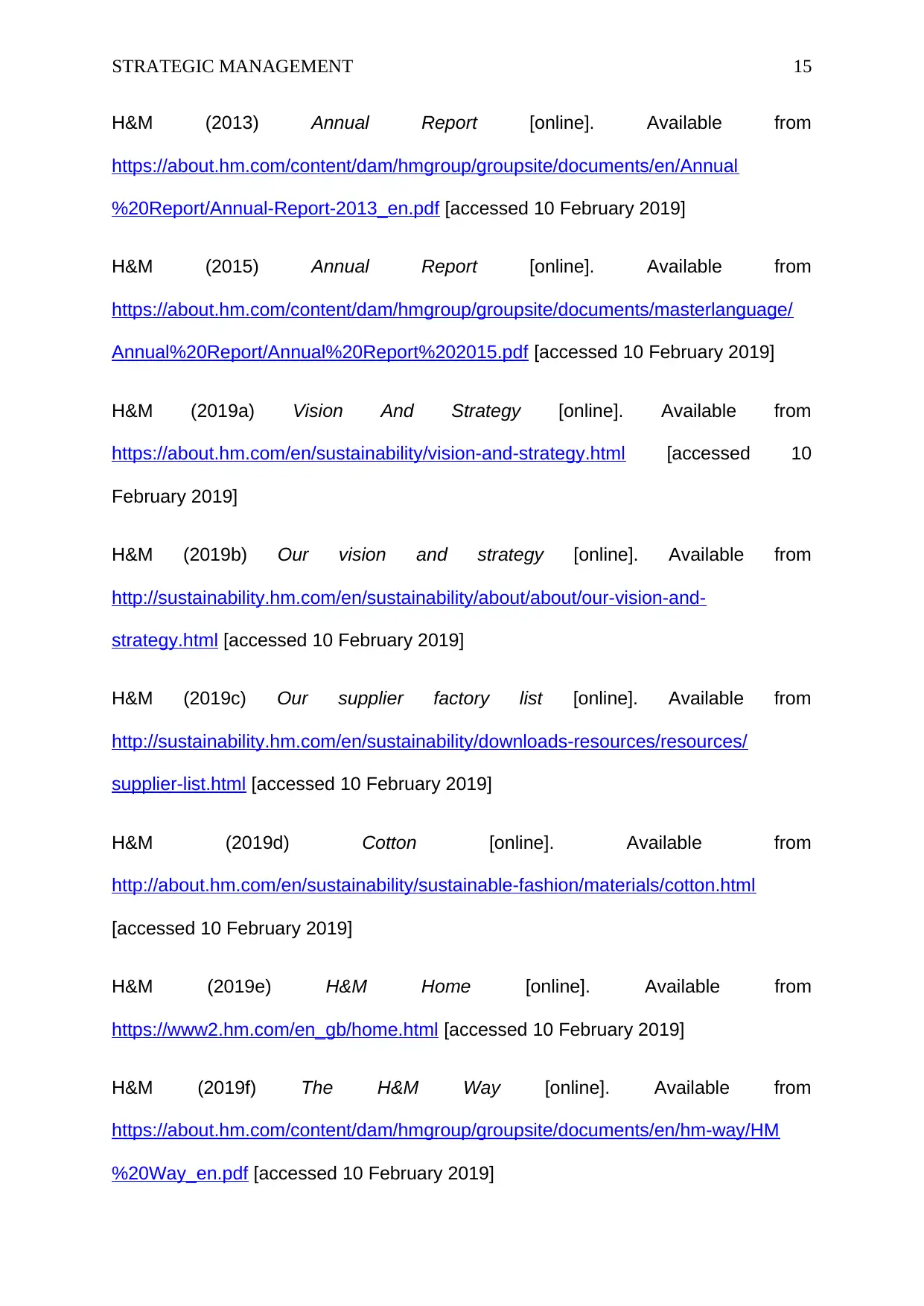
STRATEGIC MANAGEMENT 15
H&M (2013) Annual Report [online]. Available from
https://about.hm.com/content/dam/hmgroup/groupsite/documents/en/Annual
%20Report/Annual-Report-2013_en.pdf [accessed 10 February 2019]
H&M (2015) Annual Report [online]. Available from
https://about.hm.com/content/dam/hmgroup/groupsite/documents/masterlanguage/
Annual%20Report/Annual%20Report%202015.pdf [accessed 10 February 2019]
H&M (2019a) Vision And Strategy [online]. Available from
https://about.hm.com/en/sustainability/vision-and-strategy.html [accessed 10
February 2019]
H&M (2019b) Our vision and strategy [online]. Available from
http://sustainability.hm.com/en/sustainability/about/about/our-vision-and-
strategy.html [accessed 10 February 2019]
H&M (2019c) Our supplier factory list [online]. Available from
http://sustainability.hm.com/en/sustainability/downloads-resources/resources/
supplier-list.html [accessed 10 February 2019]
H&M (2019d) Cotton [online]. Available from
http://about.hm.com/en/sustainability/sustainable-fashion/materials/cotton.html
[accessed 10 February 2019]
H&M (2019e) H&M Home [online]. Available from
https://www2.hm.com/en_gb/home.html [accessed 10 February 2019]
H&M (2019f) The H&M Way [online]. Available from
https://about.hm.com/content/dam/hmgroup/groupsite/documents/en/hm-way/HM
%20Way_en.pdf [accessed 10 February 2019]
H&M (2013) Annual Report [online]. Available from
https://about.hm.com/content/dam/hmgroup/groupsite/documents/en/Annual
%20Report/Annual-Report-2013_en.pdf [accessed 10 February 2019]
H&M (2015) Annual Report [online]. Available from
https://about.hm.com/content/dam/hmgroup/groupsite/documents/masterlanguage/
Annual%20Report/Annual%20Report%202015.pdf [accessed 10 February 2019]
H&M (2019a) Vision And Strategy [online]. Available from
https://about.hm.com/en/sustainability/vision-and-strategy.html [accessed 10
February 2019]
H&M (2019b) Our vision and strategy [online]. Available from
http://sustainability.hm.com/en/sustainability/about/about/our-vision-and-
strategy.html [accessed 10 February 2019]
H&M (2019c) Our supplier factory list [online]. Available from
http://sustainability.hm.com/en/sustainability/downloads-resources/resources/
supplier-list.html [accessed 10 February 2019]
H&M (2019d) Cotton [online]. Available from
http://about.hm.com/en/sustainability/sustainable-fashion/materials/cotton.html
[accessed 10 February 2019]
H&M (2019e) H&M Home [online]. Available from
https://www2.hm.com/en_gb/home.html [accessed 10 February 2019]
H&M (2019f) The H&M Way [online]. Available from
https://about.hm.com/content/dam/hmgroup/groupsite/documents/en/hm-way/HM
%20Way_en.pdf [accessed 10 February 2019]
Secure Best Marks with AI Grader
Need help grading? Try our AI Grader for instant feedback on your assignments.
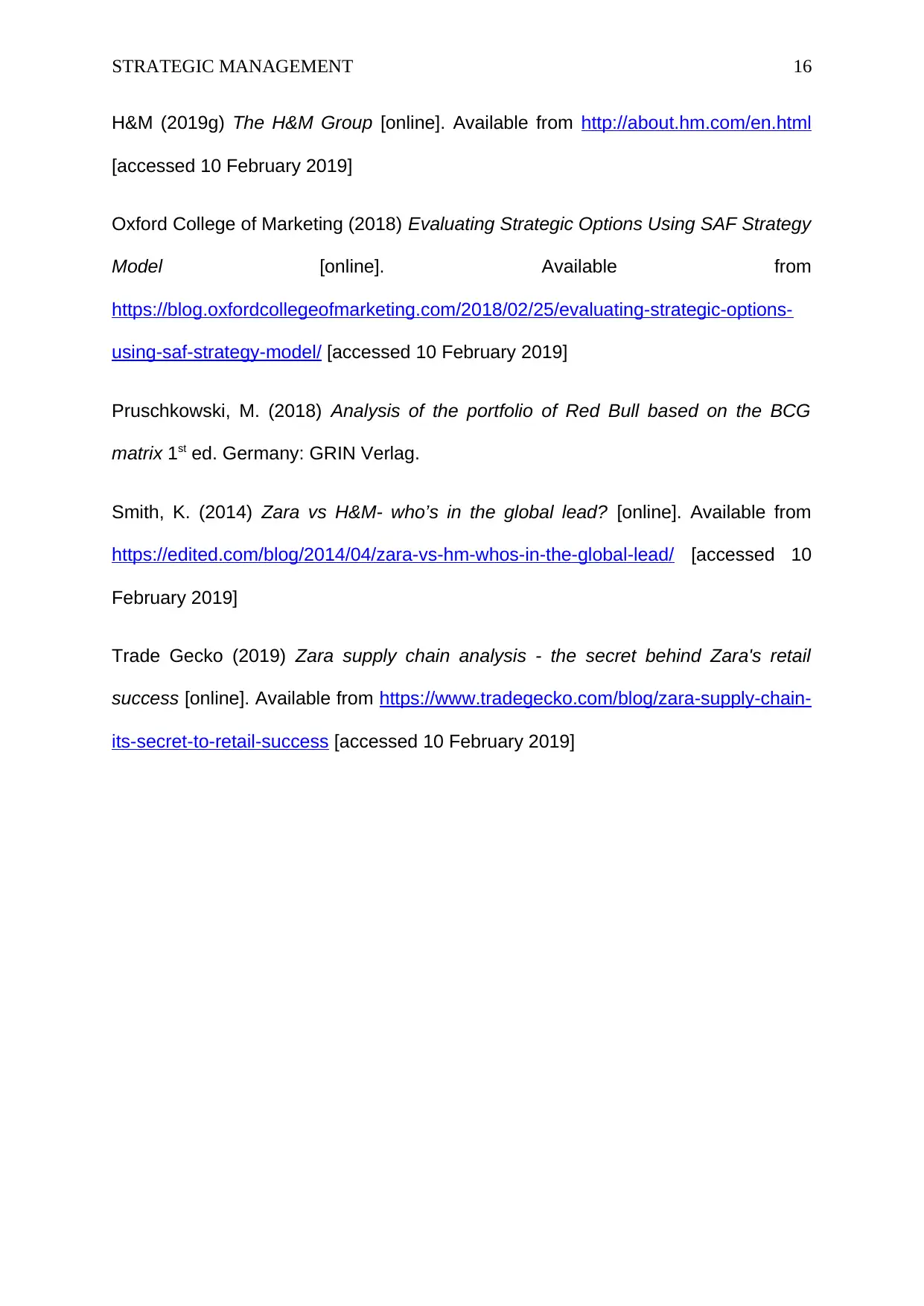
STRATEGIC MANAGEMENT 16
H&M (2019g) The H&M Group [online]. Available from http://about.hm.com/en.html
[accessed 10 February 2019]
Oxford College of Marketing (2018) Evaluating Strategic Options Using SAF Strategy
Model [online]. Available from
https://blog.oxfordcollegeofmarketing.com/2018/02/25/evaluating-strategic-options-
using-saf-strategy-model/ [accessed 10 February 2019]
Pruschkowski, M. (2018) Analysis of the portfolio of Red Bull based on the BCG
matrix 1st ed. Germany: GRIN Verlag.
Smith, K. (2014) Zara vs H&M- who’s in the global lead? [online]. Available from
https://edited.com/blog/2014/04/zara-vs-hm-whos-in-the-global-lead/ [accessed 10
February 2019]
Trade Gecko (2019) Zara supply chain analysis - the secret behind Zara's retail
success [online]. Available from https://www.tradegecko.com/blog/zara-supply-chain-
its-secret-to-retail-success [accessed 10 February 2019]
H&M (2019g) The H&M Group [online]. Available from http://about.hm.com/en.html
[accessed 10 February 2019]
Oxford College of Marketing (2018) Evaluating Strategic Options Using SAF Strategy
Model [online]. Available from
https://blog.oxfordcollegeofmarketing.com/2018/02/25/evaluating-strategic-options-
using-saf-strategy-model/ [accessed 10 February 2019]
Pruschkowski, M. (2018) Analysis of the portfolio of Red Bull based on the BCG
matrix 1st ed. Germany: GRIN Verlag.
Smith, K. (2014) Zara vs H&M- who’s in the global lead? [online]. Available from
https://edited.com/blog/2014/04/zara-vs-hm-whos-in-the-global-lead/ [accessed 10
February 2019]
Trade Gecko (2019) Zara supply chain analysis - the secret behind Zara's retail
success [online]. Available from https://www.tradegecko.com/blog/zara-supply-chain-
its-secret-to-retail-success [accessed 10 February 2019]
1 out of 17
Related Documents
Your All-in-One AI-Powered Toolkit for Academic Success.
+13062052269
info@desklib.com
Available 24*7 on WhatsApp / Email
![[object Object]](/_next/static/media/star-bottom.7253800d.svg)
Unlock your academic potential
© 2024 | Zucol Services PVT LTD | All rights reserved.





